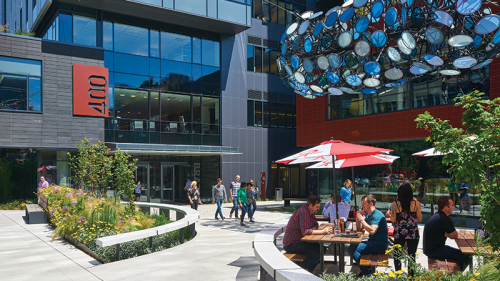Spring Meeting
Two developers who have been major forces behind the city’s resurgence said that the struggle to overcome hard times has positioned Detroit for robust growth.
ProMedica Plaza and Promenade Park opened in August 2017, occupying 11 acres (4.5 ha) along the Maumee River in Toledo, Ohio. To create a more efficient workplace and demonstrate a commitment to Toledo’s core, Randy Oostra, ProMedica’s chief executive officer, chose to relocate administrative staff from 20 locations to a new, unified headquarters in the city.
Western Michigan—which includes Grand Rapids, Muskegon, Holland, and Kalamazoo—has a long history in agribusiness. But the region also has rapidly growing life sciences clusters specializing in everything from medical equipment and surgical devices, to a robust manufacturing sector, focused on metals, plastics, biopharmaceuticals, and automotive products, as well as office furniture.
Detroit’s design community has set an ambitious vision—to become a global leader in the practice of inclusive design in order to drive more inclusive growth.
Jill Ferrari, a partner at Shelborne Development and vice chair of ULI Michigan, and Eric Larson, chief executive officer of both the Larson Realty Group and the Downtown Detroit Partnership, who is also serving as a co-chair of the ULI Spring Meeting Host Committee, were recently interviewed on a podcast produced by Crain’s Detroit Business.
With his own Quicken Loans headquarters, historic rehabs—and a new Shinola boutique hotel—Dan Gilbert’s Bedrock Detroit brings back the cool.
Alphabet, Amazon, and Facebook are just a few of the tech giants snapping up space.
Philadelphia is proud of its food culture and has a great restaurant scene in Center City. But outside the center, the city of 1.6 million has a 26 percent poverty rate and a need for affordable healthy food.
Since Congress legalized crowdfunding for real estate projects in 2012, the internet-based financing source has grown dramatically, from $396.4 million in 2013 to $2.5 billion in 2015, according to the Los Angeles–based research and advisory firm Massolutions.
Everyone’s talking about “what’s next” in terms of emerging urban neighborhoods, where property values can surge very rapidly. But why do some districts emerge seemingly out of nowhere? How can developers and investors find the next one?






